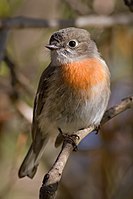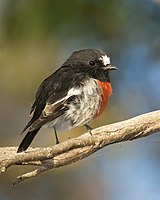| Scarlet robin | |
|---|---|

| |
| Male | |

| |
| Female | |
| Conservation status | |
 Least Concern (IUCN 3.1) | |
| Scientific classification | |
| Domain: | Eukaryota |
| Kingdom: | Animalia |
| Phylum: | Chordata |
| Class: | Aves |
| Order: | Passeriformes |
| Family: | Petroicidae |
| Genus: | Petroica |
| Species: | P. boodang |
| Binomial name | |
| Petroica boodang (Lesson, RP, 1837) | |

| |
| Distribution map | |
| Synonyms | |
|
Petroica multicolor boodang | |

The scarlet robin (Petroica boodang) is a common red-breasted Australasian robin in the passerine bird genus Petroica. The species is found on continental Australia and its offshore islands, including Tasmania. The species was originally split in 1999 by Schodde and Mason, and as the original collection by Gmelin was from Norfolk Island, this retained the name of multicolor, and is now known as the Norfolk robin.
Taxonomy
There are three recognised subspecies of Petroica boodang: the nominate subspecies P.b.boodang is found in mainland southeastern Australia; P.b.leggii is found in Tasmania and Flinders Island in the Bass Strait; and P.b.campbelli occurs in southwestern Western Australia.
Description
Like the rest of the Australasian robins, the scarlet robins are stocky passerines with large heads. They range in size from 12 to 13.5 cm in length and weigh between 12 and 14 g. The plumage is sexually dimorphic. The males have black heads, backs and tails, black and white wings, a scarlet red breast, and white belly, forehead and rump. The female matches the male in pattern, but is duller, with brown plumage instead of black, a much more washed-out red on the breast, and a buff belly. Juvenile birds resemble the female without the reddish wash on the breast.
Distribution, movements and habitat
The scarlet robin is endemic to Australia, where it is found near the coast from southern Queensland to central South Australia, Tasmania and southwest Western Australia. The species is mostly sedentary over its range, but some mainland populations undergo small local movements in the autumn and winter, either to more open habitats or to lower elevations.
The scarlet robin is most commonly found in eucalyptus woodland and forest, from sea level to 1000 m, particularly the more open habitats with grassy and shrubby understories. During the winter, more open environments, including urban habitats, are frequented.
Behaviour
The scarlet robin feeds on arthropods, such as insects and spiders. It adjusts its foraging behaviour seasonally, feeding mostly on the ground during the winter, but during the summer and spring prey is more commonly snatched from bark and foliage.
Breeding biology
The scarlet robin is a territorial and monogamous species, and defends its nesting territories both from others of the same species and from pairs of the related flame robin. Territories are established and breeding commences before the migratory flame robin arrives in its range (where the two co-occur). Both the male and the female participate in selecting the nesting site, but only the female constructs the nest, a task which takes four to ten days. The clutch size is between one and four eggs, with three being the average. The eggs are grey, green or pale blue, and marked with brown to olive-brown splotches and spots, usually concentrated around the large end. Only the females incubate the eggs, and the males feed the females on the nest. The chicks hatch after 14 to 18 days. At first, they are brooded by the female and fed by the male; when brooding ends, they are fed by both parents. Nesting success is generally low, between 8 and 40%. Scarlet robin nests are raided by snakes, and they are victims of brood parasitism by various species of cuckoo.
Gallery
-
 Female
Female
Victoria, Australia -
 Female
Female
Hobart, Tasmania -
 Male
Male
Meehan Range, Tasmania -
 Male
Male
Mortimer Bay, Tasmania
See also
References
- BirdLife International (2017). "Petroica boodang". IUCN Red List of Threatened Species. 2017: e.T22735719A112749310. doi:10.2305/IUCN.UK.2017-1.RLTS.T22735719A112749310.en. Retrieved 13 November 2021.
- "Petroica boodang". Avibase.
- Schodde R, Mason IJ (1999). The Directory of Australian Birds: Passerines. A Taxonomic and Zoogeographic Atlas of the Biodiversity of Birds in Australia and its Territories. Collingwood, Australia: CSIRO Publishing. p. x 851 pp. ISBN 0-643-06456-7.
- Gill, F. and D. Donsker, eds. (2020). IOC World Bird List (v 10.1). doi:10.14344/IOC.ML.10.1.
- ^ Boles, W (2007) "Family Petroicidae (Australasian Robins)" in del Hoyo, J.; Elliot, A. and Christie D. (editors). (2007). Handbook of the Birds of the World. Volume 12: Picathartes to Tits and Chickadees. Lynx Editions. ISBN 978-84-96553-42-2 pp. 482–483
- Robinson, D (1992). "Habitat use and foraging behaviour of the scarlet robin and the flame robin at a site of breeding-season sympatry". Wildlife Research. 19 (4): 377–395. doi:10.1071/WR9920377.
- ^ Robinson, D (1989). "Interspecific Aggression and Territorial Behavior Between Scarlet Robin Petroica multicolor and Flame Robin P. phoenicea". Emu. 89 (2): 93–101. doi:10.1071/MU9890093.
- ^ Robinson, D (1990). "The Nesting Ecology of Sympatric Scarlet Robin Petroica multicolor and Flame Robin Petroica phoenicea Populations in Open Eucalypt Forest". Emu. 90 (1): 40–52. doi:10.1071/MU9900040.
External links
- Birds of Canberra Gardens website's Scarlet Robin page, canberrabirds.org.au
- Scarlet Robin videos on the Internet Bird Collection, lynxeds.com
- Birds in Backyards' Scarlet Robin page, birdsinbackyards.net